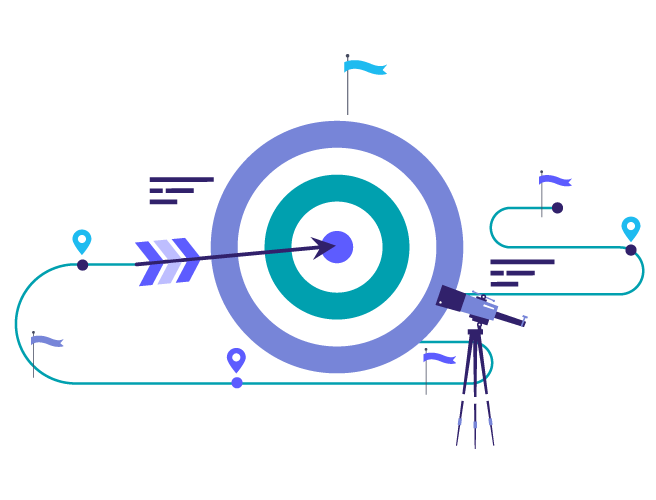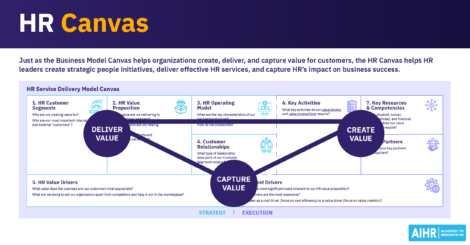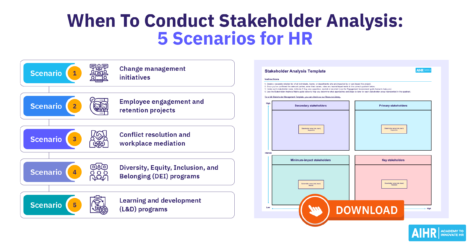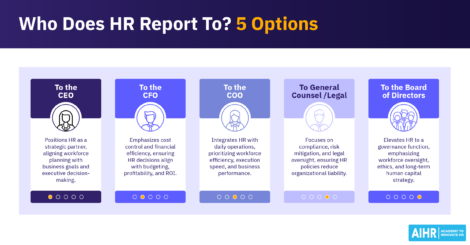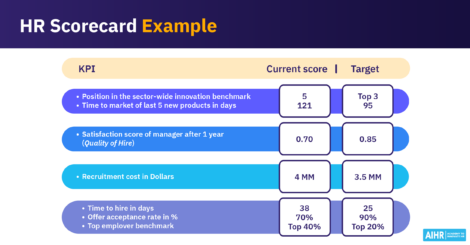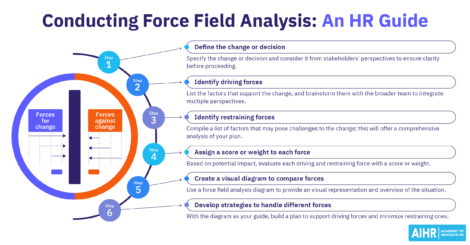What is the HR Business Partner model?
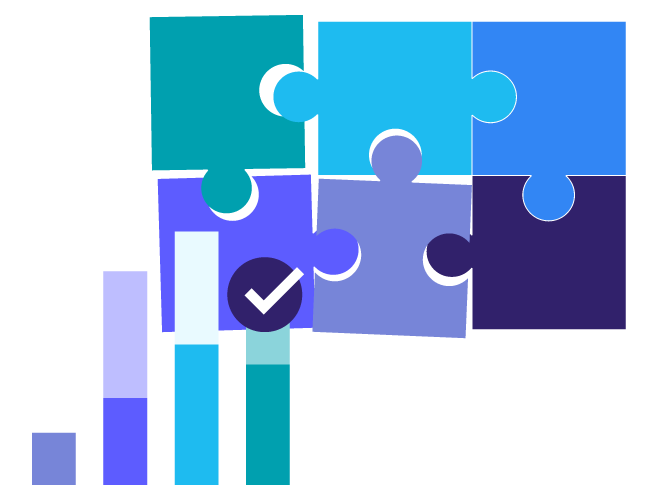
The HR Business Partner model is a framework for organizing a company’s HR function so that it can deliver strategic business value.
The HRBP model was first introduced in 1996 by Dave Ulrich and is, therefore, also referred to as the Ulrich (HR) model. The basic principles of the model are as follows:
- HR departments take on more strategic roles
- HR professionals are closer to the business
- Improving the effectiveness of HR through centers of excellence, shared services, and HRBPs.
The Ulrich model is widely used and very popular for various reasons, including:
- Because it creates a more flexible and responsible HR organization
- Because it promotes collaboration across the entire company and;
- Because it enables an alignment between HR practices and the organization’s strategy and objectives.
HR Business Partner model vs. traditional HR model
In the traditional setup, the HR department is organized into specialized functions like Recruitment, Employee Relations, Learning and Development, Compensation and Benefits, and HR Administration.
Each function operates as a separate unit, often with its own manager, and focuses on specific areas of HR. The benefits of this traditional HR model are:
- There are clear roles and responsibilities
- There is a depth of expertise in specific areas.
The drawbacks of this model are:
- It can lead to silos
- There is less flexibility in the HR function
- Decision-making tends to be slower.
In the HRBP model, HR is designed to be more integrated and business-focused. Instead of working in isolation, HR functions are organized into three interconnected pillars—HR Business Partners, Centers of Excellence, and Shared Services—all aimed at delivering strategic value.
This setup enhances collaboration, speeds up decision-making, and ensures that HR is closely aligned with business needs.
HR Business Partner model structure
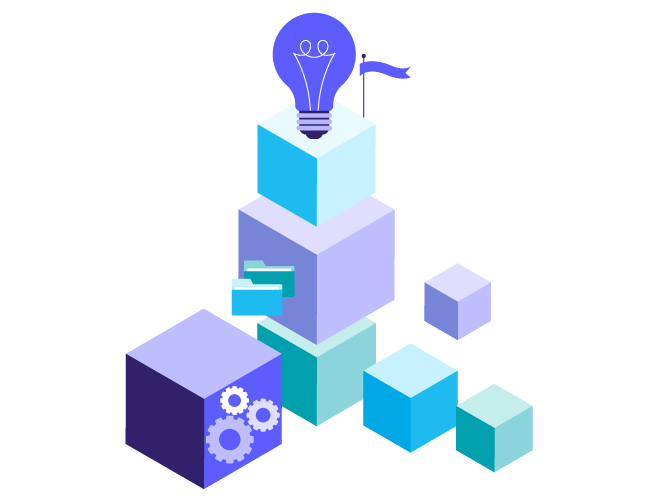
Let’s unpack the HR Business Partner model and dive deeper into its structure.
HR Leadership
The HRBP model is also known as the three-legged stool. The strategic leadership team that designs the HR organization and ensures that HR can deliver on its people priorities forms the top of this stool. Their role is to collaborate closely with senior management to shape workforce strategies that drive organizational success.
The three legs of the stool consist of HR Shared Services, HR Centers of Excellence, and HRBPs. 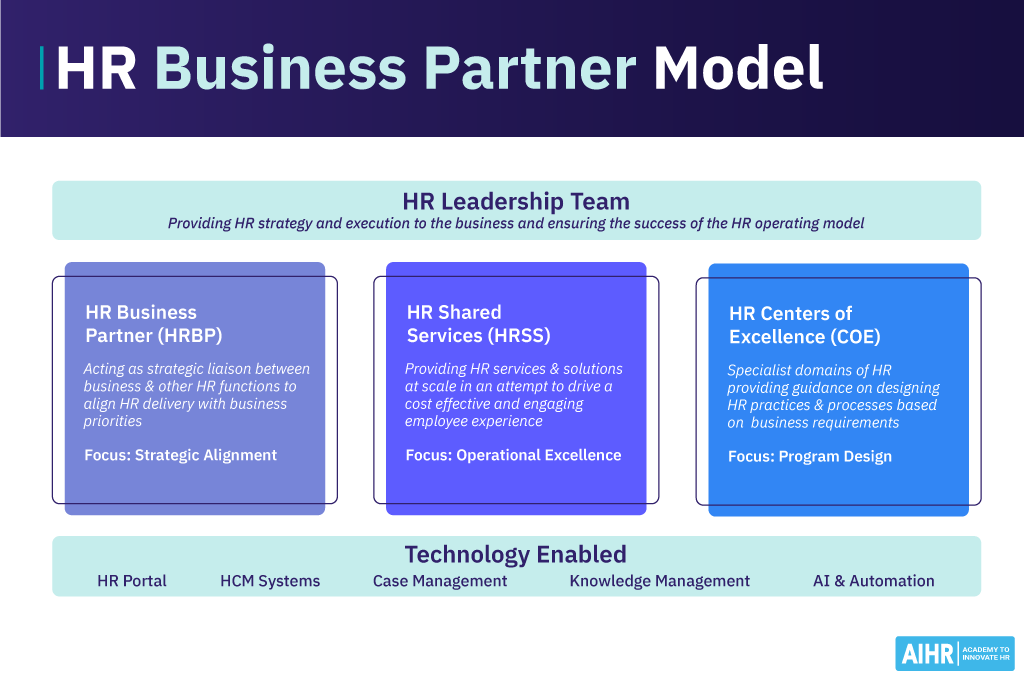
HR Shared Services
HR Shared Services refer to a centralized hub of operational and administrative HR duties. They are characterized by:
- Employee self-service and automation through leveraging technology
- Multi-tiered levels of service and service responses.
An HR Shared Services setup enables organizations to provide standard HR services in an optimal manner. Think, for example, of services such as:
- Payroll
- Employee data management
- Benefit and leave administration
- Recruiting operations
- Learning services.
Organizations that implement HR Shared Services successfully reap various benefits from doing so, including:
- Consistency and compliance: HR matters are always handled consistently, ensuring compliance with rules and regulations.
- Improved employee experience: Employees can find relevant information more easily and resolve issues faster, which positively affects their digital and overall employee experience.
- Operational excellence: Optimized workflows and streamlined processes enable organizations to reach operational excellence.
HR Centers of Excellence
An HR Center of Excellence (HR CoE) is a specialized team within a company’s HR department that focuses on strategies, the development and implementation of best practices, and tools in particular areas of HR expertise, such as learning and development or compensation and benefits.
Key features of an HR Center of Excellence include:
- Innovation
- Deep expertise
- Scalability
- Collaboration
- A focus on continuous improvement.
An HR CoE aims to optimize HR processes and ensures that HR activities are effective, efficient, and aligned with the organization’s goals.
Traditionally, CoEs worked somewhat separately from an organization’s daily business operations. However, as the HR landscape and business needs evolve, so does the role of the HR Centers of Excellence.
Modern HR CoEs are often smaller expert teams that support HRBPs more flexibly. They focus on practical solutions that directly impact business performance and emphasize data and analytics, strategic workforce planning, and D&I.
HR Business Partners
HR Business Partners (HRBPs) are HR professionals who work closely with specific business units or departments within an organization to align HR practices with business objectives. In the HR Business Partner model, HRBPs serve as strategic advisors and consultants to managers and leaders, translating the organization’s overall strategy into people-related solutions.
The HRBP function includes different roles at various levels of seniority, such as HR Business Partners, Senior HRBPs, and the CHRO, to ensure continuous alignment between HR and business needs.
There’s a difference between what some may call administrative business partners and future-ready HRBPs. The former sits down with a manager, asks how they can help, gets a to-do list, and takes notes.
The latter operate differently. They analyze specific data before meeting with a manager to see where the manager needs help. They also review that manager’s KPIs and enter the meeting with actionable plans.
The HR Business Partner role needs to become more strategic to truly help organizations increase their productivity, profitability, and competitiveness.
Here’s what the responsibilities of a strategic HR Business Partner should look like:
- Preparing for the future of work and Human Resource management
- Being a consultant and a coach
- Putting business acumen to work
- Building a competitive organization
- Empowering leaders
- Using data to influence decisions
- Strengthening employee experience and company culture.
Benefits of the HR Business Partner model
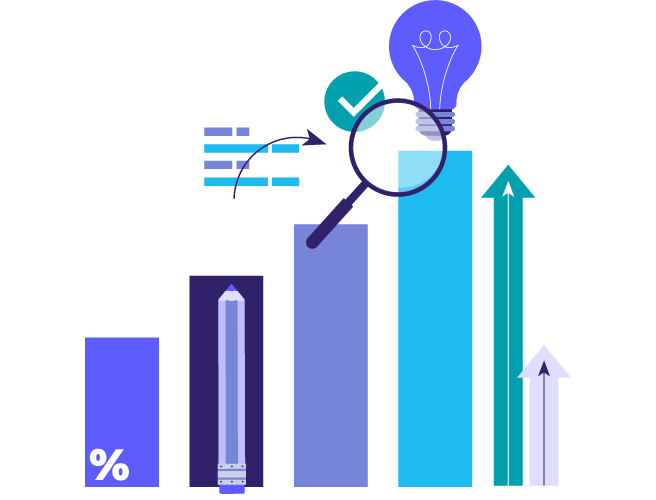
The HR business partner model has various benefits, including:
A more strategic approach
The biggest benefit of the Ulrich model is that it has created a massive shift for HR from the traditional, mostly administrative role to one that actively supports business strategy.
For HR practitioners, this means a greater impact on driving organizational success by designing HR initiatives and solutions that directly address business priorities and challenges.
For the business, it leads to improved overall performance and decision-making in people-related matters through a more strategic HR input.
Strengthening employee and business relations
When well implemented, the HR business partner model strengthens employee and business relations. An example on the employee side is HR self-service options that improve day-to-day experiences by streamlining processes and making HR support more accessible. The HRBP model also fosters close collaboration and productive relationships between departments. This close partnership helps the business stay agile and respond more effectively to challenges.
HR specialization
The model encourages HR specialization – for example, in the HR Centers of Excellence – and enables HR professionals to focus on specific areas, such as employee relations or talent management, increasing their expertise in those areas.
This deeper specialization allows for more informed decision-making, better-tailored solutions, and a higher level of support for both employees and the business.
Faster decision-making
The HRBP model speeds up decision-making by embedding HR professionals within the business, allowing them to access relevant information and provide real-time solutions quickly.
With a direct understanding of business needs and closer collaboration with leadership, HR can address issues more promptly and make decisions that are aligned with the company’s immediate and long-term goals. This reduces delays caused by siloed functions and improves overall responsiveness.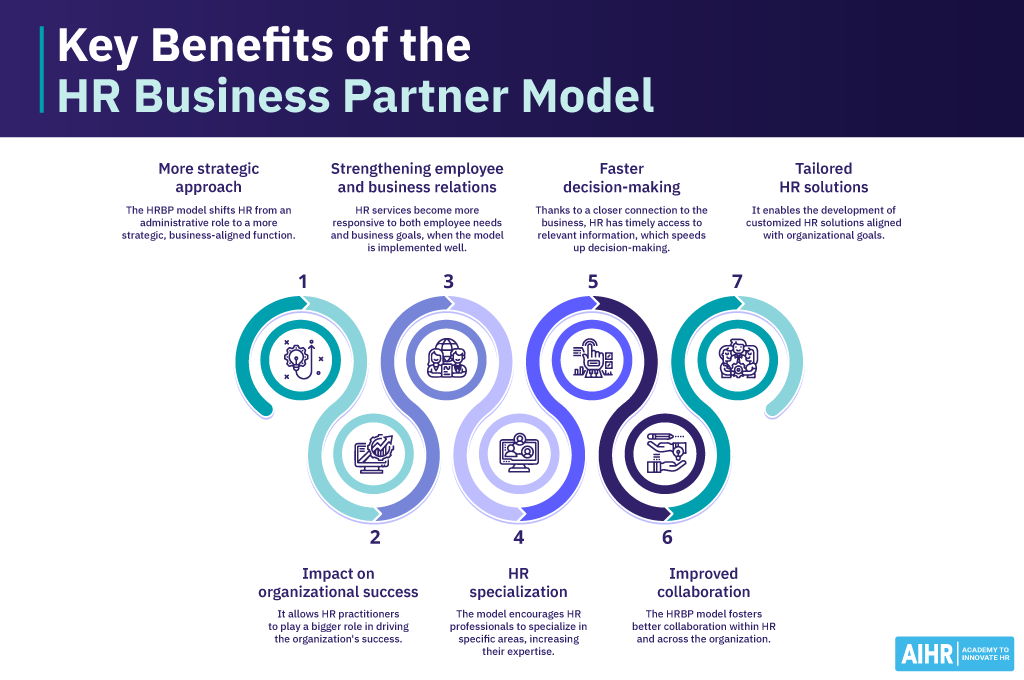
Improved HR collaboration
The HRBP model enhances collaboration within the HR function itself by connecting HRBPs, Centers of Excellence, and Shared Services.
This structure allows for better information sharing and coordination between specialized HR teams, ensuring that expertise from different areas is effectively combined to create comprehensive solutions. The result is a more cohesive HR function that works together to address complex issues swiftly.
Tailored HR solutions
The HRBP model allows for customized solutions based on the unique needs of different departments.
For instance, the sales department might require tailored performance management strategies that prioritize meeting sales targets, rewarding high performers through variable pay, and tracking performance metrics closely tied to revenue generation. Meanwhile, the R&D department may need specialized talent management programs that emphasize innovation, skill development, and long-term project timelines.
By working closely with each department, HRBPs ensure that HR solutions are aligned with the distinct goals and challenges of each area rather than applying a one-size-fits-all approach.
Is your HRBP model delivering the maximum impact?
If your organization already operates using the HR business partner model but you believe that it isn’t achieving its maximum impact yet, you can take AIHR’s HRBP Impact Assessment.
The process is simple:
- Take the assessment
- Instantly get the results and recommendations in a report
- Benchmark your results against other companies and receive practical advice on how to improve against five focus areas
- Discover actionable insights better to position your HR team as a strategic partner.
HRBP as a role vs. a function vs. a capability
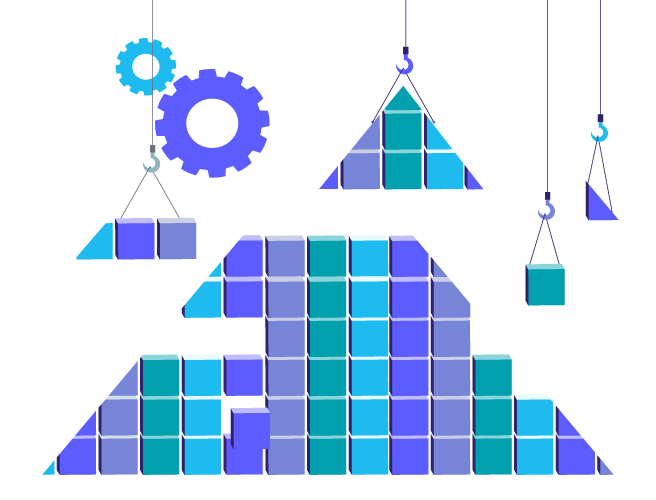
The terms “HR Business Partner” and “business partnering” can mean different things depending on the context.
HRBP as a job role
In this case, the term HRBP refers to professionals with the actual job title HR Business Partner. HRBPs, first and foremost, form a strategic link between HR and the business. They primarily work with managers to ensure the company’s HR activities align with their needs.
HRBPs take on a variety of responsibilities in a company. Gartner has identified four roles demonstrating how versatile the HRBP is:
- Operations manager
- Emergency responder
- Strategic partner
- Employee mediator.
The HR Business Partner role is constantly evolving, driven by changes in the job market and developing trends in the world of work.
Unlike traditional HR roles focused on payroll and employee administration, HRBPs are tasked with:
- Aligning HR strategies with business objectives
- Ensuring compliance with HR regulations
- Being a strategic advisor to senior leaders
- Facilitating performance management processes
- Coaching managers on effective leadership practices
- Managing employee relations
- Supporting organizational change initiatives.
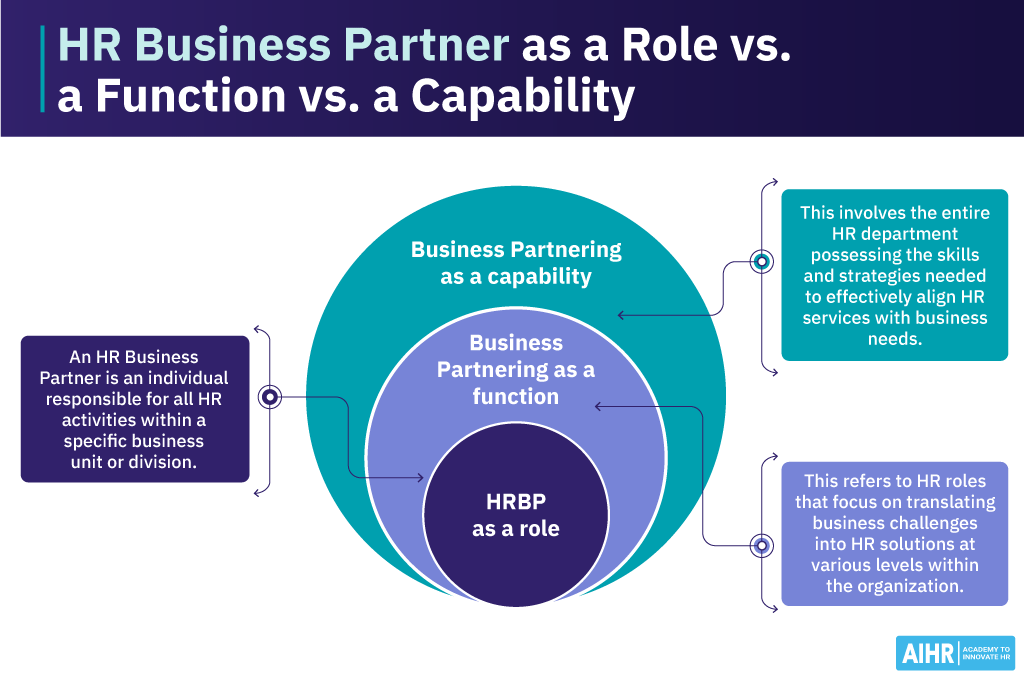
HRBP as a function
The HRBP function refers to a variety of business-facing HR roles responsible for translating business challenges into HR solutions. These roles exist at different levels of seniority. They partner with the business across various leadership tiers to ensure continuous alignment between HR and business needs.
Depending on the business structure and the HR operating model, the HRBP function could include the following roles:
- HRBPs: Every HRBP is assigned to a senior manager within different business units.
- Senior HRBPs or the HR Director: They partner with the Heads of Department.
- CHRO: They partner with the organization’s CEO and Executive team.
Collectively, these roles form the Business Partnering function, which is one of the key “legs” of the Ulrich model. It works alongside Shared Services and Centers of Excellence.
In practice
“In our organization, the BP function consists of the CHRO who partners with executives, Senior HRBPs who partner with divisions, HRBPs who partner with departments, HR Consultants who partner with a specific business team, and HR Administrators who partner with employees.”
Business partnering as a capability or a skill
Finally, we have the term business partnering as a capability or a skill. This refers to the entire HR department having the skills, knowledge, and experience to engage with the business to deliver HR services.
It means that, beyond specific HRBP roles, the entire HR team should have a good level of business acumen to understand business needs, communicate effectively with stakeholders, and deliver tailored HR services that directly support organizational goals.
In essence, business partnering as a capability means that every member of the HR team, from generalists to specialists, should be able to approach their work with a business-first mindset.
In practice
“While not everyone in the HR department is a business partner, everyone in the people team should be ‘business partnering.’ This means that every HR professional deeply understands the business and tries to shape HR policies in such a way that helps to enable the company.”
HR Business Partner role
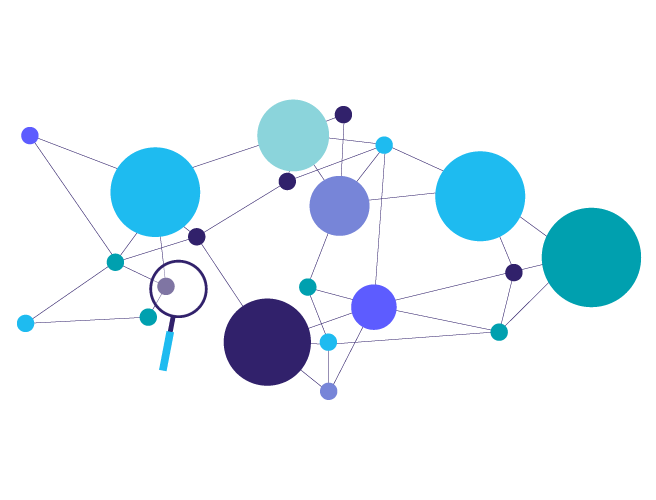
When talking about the HR Business Partner as a job role, their main goal is to create a bridge between HR and the business. They have a solid knowledge of that business and know how to help the organization achieve its goals.
But what exactly does this look like in practice? What does the HRBP as a job role entail?
HR Business Partner job description
An HR business partner job description will vary from one company to another. However, some typical responsibilities, competencies, and qualification requirements will appear frequently in a job ad for this role.
Responsibilities
The typical HR Business Partner responsibilities include:
- Strategic planning: A good HRBP is able to help the company they work for become future-ready. They focus on the existing workforce and prepare them for the future through reskilling and upskilling. They also identify future talent needs and create strategies to hire and retain the right talent to meet evolving business goals.
- Coaching and consulting leadership on HR matters: An HR Business Partner clearly understands how current and future challenges affect the people in the organization so that they can give adequate advice and coaching to key stakeholders.
- Building a competitive organization: HRBPs play a critical role in shaping an organization that can outperform competitors. They align talent strategies with business goals to equip the organization with the skills and leadership it needs to succeed. By fostering employee engagement, developing high performers, and improving overall workforce capabilities, HRBPs enable the business to deliver superior products or services, ultimately strengthening the company’s market position.
- Being an employee experience (EX) and company culture champion: A core responsibility of every HRBP is to continuously improve the employee experience and maintain a strong organizational culture.
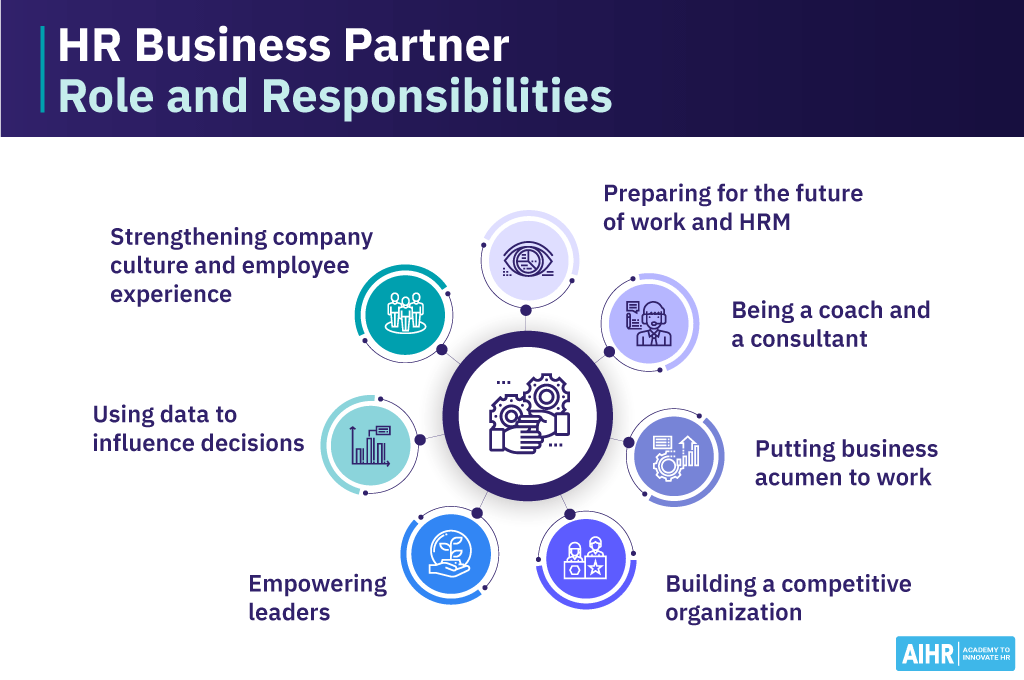
Qualifications
Companies often require their HRBP job applicants to have a Bachelor’s or Master’s degree in a field related to Human Resources Management, business management and administration, or organizational studies.
An HR Business Partner certification is not mandatory but can give candidates an extra edge during the application process.
HR Business Partner skills of the future
There are a couple of skills in particular that any future-oriented HR business partner needs to succeed in their role. Successful HR Business Partners are T-shaped, meaning that they master five core HR competencies that any HR professional should possess:
- Business Acumen: HRBPs must have a deep understanding of market trends and customer needs, commercial fluency, and the ability to create strategies that align HR initiatives with broader business objectives. This enables them to contribute to sustainable business results directly.
- Data Literacy: The ability to work with data is essential for modern HRBPs. They need to have data awareness–knowledge of what data is available, how it is collected, and how it can be used effectively. They can apply and communicate data effectively. This helps them derive actionable insights that inform decision-making and increase HR’s impact on the business.
- Digital Agility: HRBPs must be champions of digital adoption, using technology to drive HR’s effectiveness. They prepare the organization for digital transformation, streamline and future-proof HR processes, and, ultimately, help the business remain competitive in a digital world.
- People Advocacy: HRBPs build cultures focused on employee wellbeing and productivity. They are key in managing change, mitigating risks, upholding ethics, and promoting sustainability within the organization, implementing that HR solutions support a people-centric, ethical workplace.
- Execution Excellence: This competency involves action orientation, problem-solving, and strong interpersonal skills. HRBPs must excel at engaging with stakeholders and ensuring that HR strategies are implemented effectively, driving tangible results through purposeful execution.
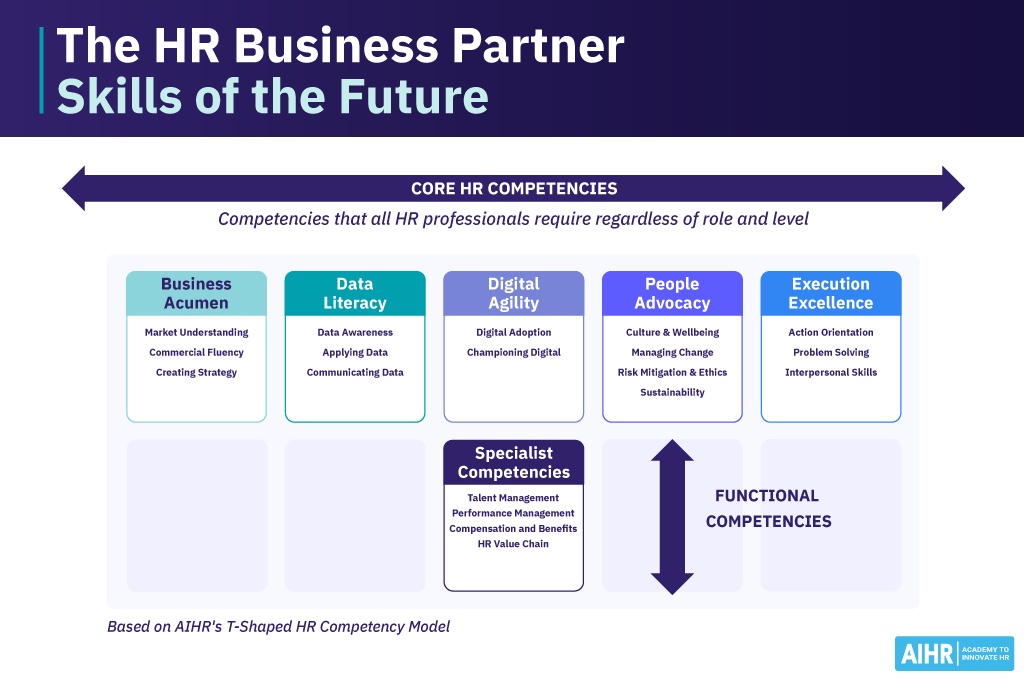
Then, there are the functional competencies relevant for any (aspiring) HR Business Partner:
- Talent management
- Performance management
- Compensation and benefits
- Understanding HR value chain.
To build a holistic employee experience (EX), HRBPs need a solid understanding of talent management, performance management, and compensation and benefits, which form the basis of the EX.
A thorough understanding of the HR value chain will equip HRBPs with the foundational knowledge they need to integrate HR policies and practices into comprehensive, business-oriented solutions.
Developing these skills
To build these HR business partner skills, it’s best to take a step-by-step approach and develop a realistic development roadmap for the HRBPs in the organization.
At AIHR, we suggest a three-phased approach that prioritizes the abovementioned skills at different times to create the fastest route to value. In a nutshell, this is what that looks like:
- Entry to the game: Building solid foundations
- Adding value: Building emerging skills
- Making an impact: Differentiating skill sets.
A day in the life of an HRBP
Here’s a sneak peek into a typical day for an HRBP.
Kick off your day with a hot or cold beverage of your choice. Start by browsing your to-do list and emails and checking your diary to prepare for scheduled meetings, including one with the VP of Customer Success.
You’ve recently reviewed data showing higher-than-expected turnover in the customer success officer role. After analyzing the exit interview data and onboarding feedback, you’ve identified a key issue: new hires feel underprepared and unsupported during their first few months.
You’ve developed a plan to address this by enhancing the onboarding process with structured touchpoints—weekly check-ins with managers and mentorship sessions with experienced team members. In today’s meeting with the VP, you present your solution and discuss implementation timelines.
Next, it’s time for lunch, followed perhaps by a short walk outside. During the second part of your day, you catch up with the CHRO to align on updates to the company’s hybrid work policy. This includes analyzing recent employee feedback on remote work and ensuring the policy supports flexibility while maintaining productivity and team cohesion. You’ll also discuss how the new policy impacts retention, particularly for top talent in leadership roles.
Finally, you wrap up your day by drafting a communication plan for rolling out the new remote work policy across the organization, keeping in mind that managers must be equipped with the right tools to support their teams in the transition. After a productive day, you shut down your laptop and get a good rest before tackling tomorrow’s challenges.
Develop strategic HRBPs
It is crucial that HRBPs have the skills they need to do their jobs well. Too often, organizations literally rebrand people as HRBPs without ensuring they have the knowledge and skills required to be actual HR business partners.
To set your HRBPs up for success, you’ll need to:
- Assess the capabilities needed
- Identify critical gaps, and
- Level-set your team.
To dive deeper into how to effectively upskill your HRBPs and ensure they deliver real business impact, check out our detailed guide for actionable insights and strategies.
When to implement the HRBP model
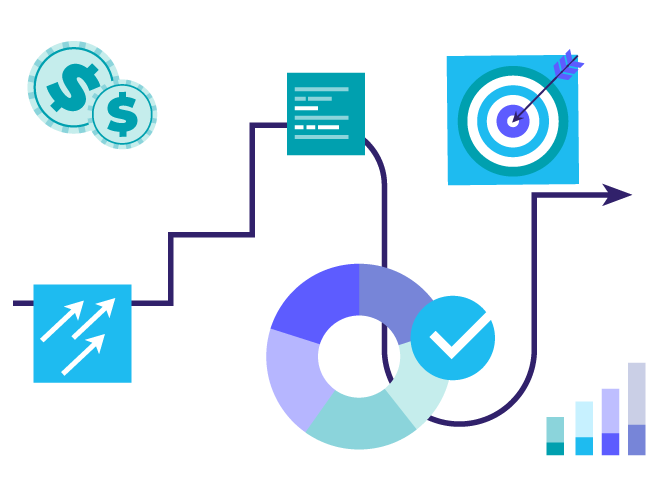
Determining whether the HR Business Partner (HRBP) model is the right solution for your business is crucial when addressing key workforce-related challenges. Not every business will benefit from the HRBP approach, but for organizations facing complex workforce issues or needing a stronger alignment between HR and business strategy, it can provide the targeted support necessary to drive effective change and achieve long-term goals.
We’ve identified five signs that indicate it is time to implement the HR Business Partner model.
1. The size and complexity of the business require a different HR solution
A larger company usually requires a different HR approach than a smaller one, even more so if the organization becomes active in multiple geographies.
There are a few signs to look out for that may indicate that it is time to switch to the HRBP model:
- The organization’s current HR framework can’t keep up with the company’s growth
- HR processes are starting to become burdensome, and as the company grows, the time it takes to respond to HR-related inquiries is increasing
- The organization’s uniform HR solution becomes ineffective as the company scales
- There is little to no strategic alignment between the organization’s business objectives and its current HR practices.
2. The business feels the pain
Unfortunately, it often takes a bit of ‘pain’, such as retention challenges, difficulties attracting new people, or low engagement levels, for the organization to realize the value of and need for a strategic HR function.
The following may indicate that this is the case:
- The company struggles to attract and retain talent
- The organization’s HR function mostly concentrates on operational and administrative tasks, while the business requires more robust HR solutions
- The company’s business leaders have different expectations about HR’s role than what HR currently does.
3. Leadership is fully on board with a different type of HR contribution
For the HRBP model to succeed, it is crucial that the organization’s business leaders buy into this new way of ‘doing’ HR. Without their full support, it will be difficult, if not impossible, for HR leaders to implement the model successfully.
Elements to look out for here include:
- The organization’s senior leadership is committed to the transformation of HR into a strategic partner within the business
- They are willing to provide the necessary resources and support changes in the organizational culture.
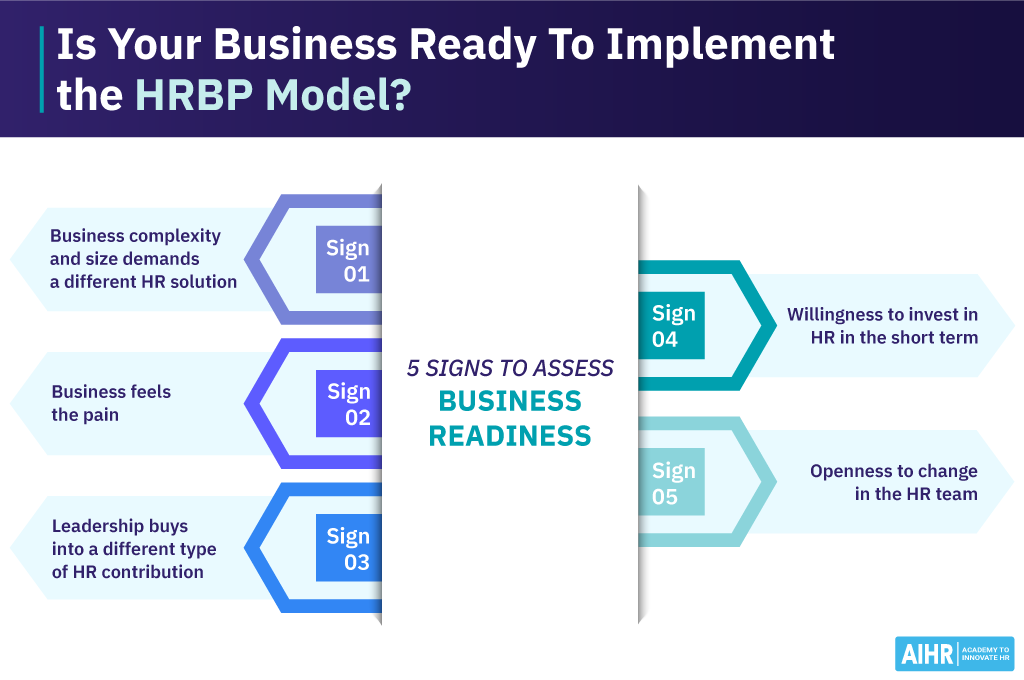
4. Willingness to invest in HR in the short term
For the HRBP model to be successful, organizations will need to invest in training, technology, and moving functions that do not belong in HR elsewhere. They need to accept that there will be increased costs in the short term.
Signs that this is the case can be:
- The business is willing to invest in HR resources
- The organization understands that moving to the HRBP model will increase costs in the short term
- The company is prepared to move non-HR-related roles to different departments.
5. The HR team itself is open to change
This is perhaps the most critical element of all: knowing whether or not the HR team is willing to adopt the HRBP model going forward.
Evaluate the team’s readiness:
- Collect feedback from the HR team to assess their willingness to adopt the HRBP model
- Assess the team’s current skill set and whether re-or upskilling, operational approaches, or role changes are required
- Develop a talent strategy that aims to either build the necessary skills internally or acquire them externally.
There are also a couple of scenarios in which adopting an HRBP model makes less sense, including:
- Organizations with a highly centralized decision-making process
- Companies in the midst of a short-term crisis or transformation
- Small organizations with little to no complexity.
Implement the HRBP model with confidence
If the organization is not yet operating using the HR business partner model and you’ve determined that it is ready to do so, use AIHR’s HRBP model implementation roadmap as a guideline.
It highlights five steps you need to take to implement the model successfully:
- Align the strategy
- Design the HRBP operating model
- Align technology and HR service delivery
- Analyze skills gaps
- Monitor performance.
Challenges in implementing the HR Business Partner model
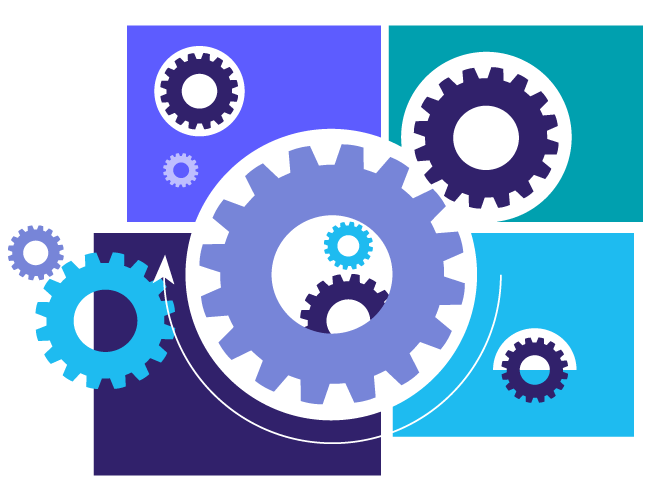
Despite its popularity, the HR business partner model falls short of delivering the anticipated results, particularly in terms of effectiveness and efficiency. In many cases, it fails to create the strategic impact on the business that leaders expect, as HR professionals may struggle to align with business priorities or influence key decisions fully.
Let’s unpack some of the most common reasons why the HRBP model fails:
- The change isn’t managed in the wider organization: Before HR teams even start to think about implementing the HRBP model, they should prepare the grounds, i.e., the organization’s business leaders. The latter need to be fully on board and willing to engage with HR differently for the HRBP model to stand a chance at succeeding.
- A strong focus on implementing the ‘ideal’ model: What often goes wrong is that organizations strive for perfection when implementing the HR Business Partner model. They forget that there will be a transition period in which both the business and HR need time to adjust and correct course where necessary.
Like a fine wine, the new model will also need some time to mature. Getting stuck in a pursuit for perfection or a high maturity state of the HRBP model will only lead to frustration and failure. - Changing job titles instead of upskilling people: Many organizations that implement the HRBP model simply rebrand their existing HR practitioners as HRBPs. They forget to enable their HR people to operate in a new way, they don’t explain to them what the new job requirements are or take the time to upskill them where necessary. Unsurprisingly, this leads to ill-equipped HRBPs who are prone to leaving the organization, frustrated managers, and a failed HRBP model.
- Lack of operational excellence: The success of the HRBP model highly depends on two factors: well-working self-service tools and a strong leadership team with a clear strategic vision. What often happens is that organizations cut multiple transactional HR roles before the self-service technologies are fully implemented, creating a significant operational void and burdening HRBPs with a disproportionate amount of administrative duties as a result. This then contributes to the perception of HR as an administrative function rather than a strategic partner.
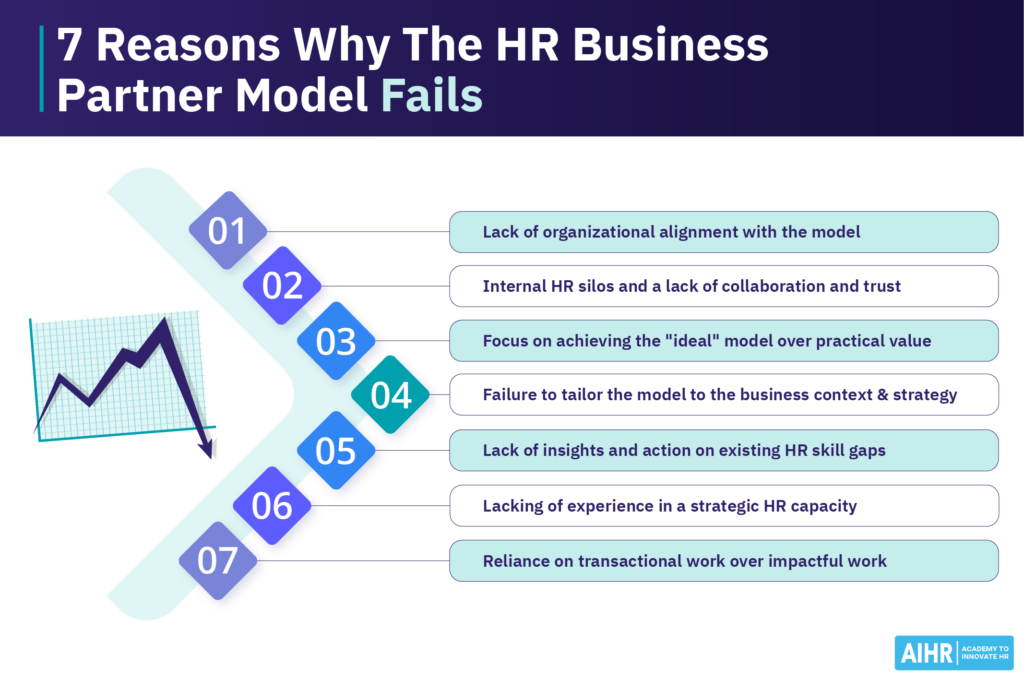
Enabling effective HR business partnering
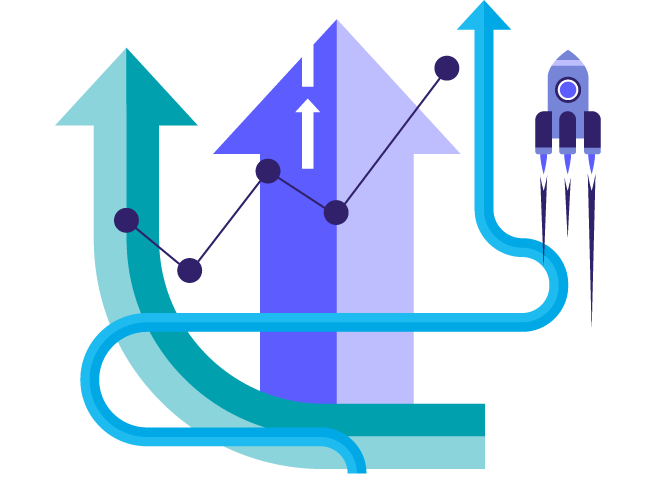
The main goal of the HRBP model is to connect HR deeper with the business; this means that it needs to be operationalized in a way that enables effective HR business partnering.
At AIHR, we have found that organizations that have successfully implemented the HRBP model share the following five success criteria:
- The HRBP model is adapted in a way that fits the business context: In organizations where HR successfully partners with the business, we’ve seen that HR teams use a custom version of the HRBP model that aligns with their specific business context. In practice, this means:
- Aligning shared services with available technologies
- Structuring HRBPs to mirror the design of the organization
- Grouping Centers of Excellence to match key HR strategic priorities.
- Business partnering is a capability not just a role: Organizations who are able to differentiate between the role of the HRBP, business partnering as a function, and business partnering as an organizational capability create internal clarity for HR and can clearly communicate HR’s value and contribution to the business.
- There’s a step-by-step approach to structured HR reskilling: Successful organizations understand the importance of an HR team that masters the skills required for an effective execution of the strategy and engagement with the business. They intentionally reskill their HR team according to a competency model that reflects the requirements of this new way of working.
- HR proactively works with the business as a key stakeholder: Effective stakeholder management is another crucial element for the success of business partnering. Under the HRBP model, HR will need to set boundaries. In practice, this means that some activities that HR has inherited will have to move back to the business. It also means that various people management responsibilities will move back to managers. This can only happen successfully if everyone involved has been implicated in the process and the upcoming changes from the start.
- Leadership fully backs one HR vision: A strong, aligned, and integrated HR leadership team is essential for a successful transition to the HRBP model. Such a team is characterized by:
- Consistent messaging about driving one HR agenda
- Being open about where responsibilities need to change and shift
- Leaning on each other
- Making collective decisions that benefit all of HR and the business
- Leaving ‘ego’ at the door.
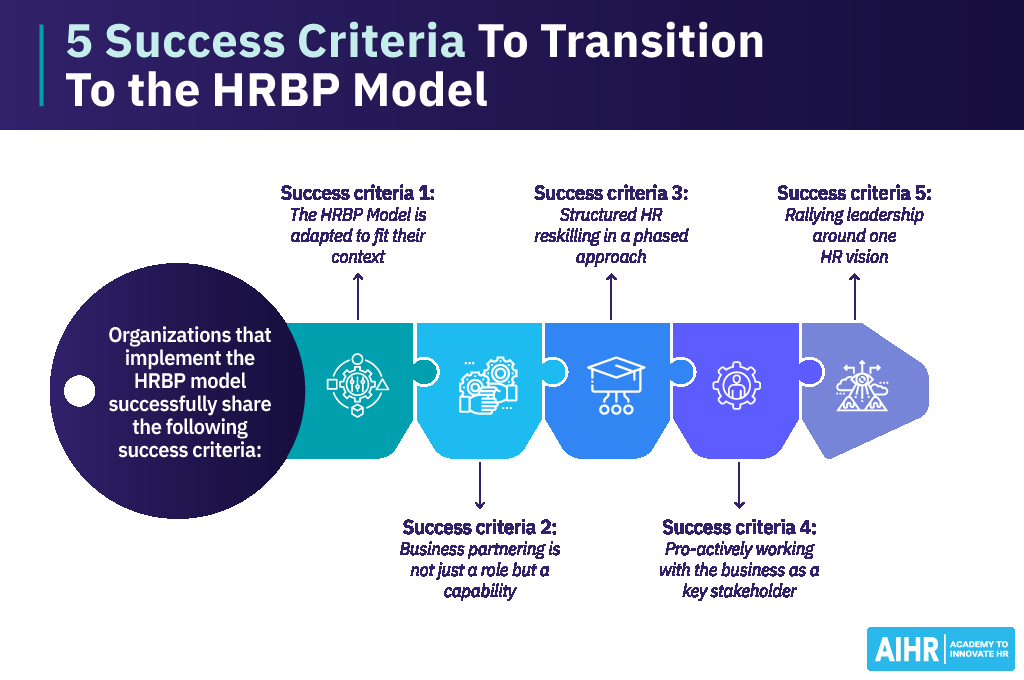
FAQ
The HR Business Partner model, also known as the Ulrich HR model or the three-legged stool, is an approach to HR that emphasizes the importance of Human Resources as a strategic partner in the business. It concentrates on delivering activities that contribute to the overall goals of the organization.
What exactly an HR Business Partner does depends on the industry and the type of company they work for. However, common responsibilities of a future-oriented HRBP include coaching and consulting business leaders, using data to influence decisions, building a competitive organization, and empowering leaders.
The HR Business Partner model operates by dividing HR functions into three key components, each playing a distinct role in delivering HR services. At the top, the HR leadership team designs the overall HR strategy and ensures alignment with business objectives.
The model’s “three legs” are HR Business Partners, who work closely with business units to provide strategic HR support; HR Centers of Excellence, which develop specialized expertise in areas like talent management and compensation; and HR Shared Services, which handle administrative tasks such as payroll and benefits. Together, these components create a more efficient, integrated approach to addressing both day-to-day and strategic HR needs.





